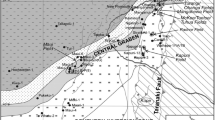Abstract
Sa'ar–Nayfa reservoir is mainly made up of carbonate sediments with bands of shale that contain a substantial amount of proven oil in the Hiswah Oilfield, Sayun–Masila Basin, eastern Yemen. Several vertical wells have been drilled and penetrated these sequences. This study is concerned on the petrophysical evaluation and well log analysis of the Lower Cretaceous of 11 wells at the Hiswah Oilfield, Hadramawt Governorate, eastern Yemen. Computer-assisted log analyses were used to evaluate the petrophysical parameters such as shale volume, total porosity, effective porosity, water saturation, hydrocarbon saturation, flushed zone saturation and reservoir and pay flags. Cross-plots of the petrophysical parameters versus depth were illustrated. The Lower Cretaceous Sa'ar–Nayfa reservoir reflects that the matrix components are mainly carbonates and shales. Moreover, the lithological-geologic model reflected that these shales are strongly affecting the porosity and, consequently, the fluid saturation in the Sa'ar–Nayfa reservoir. In this study, the thickness of the Sa'ar–Nayfa reservoir increases from central toward north-eastern and north-western parts within the Hiswah Oilfield. The porosities analyses of the investigation of the Sa'ar–Nayfa reservoir for the 11 studied wells concluded that the average total porosity ranges from 5.4 % to 16.8 % while the effective porosity ranges from 5.2 % to 14.8 %. Water saturation of the Sa'ar–Nayfa reservoir ranges from 6.9 % to 75.8 %. On the other hand, hydrocarbon saturation matches with water saturation in a reverse relationship. Sa'ar–Nayfa reservoir is interpreted as good quality reservoir rocks with high average effective porosity reaching to 20 % and high hydrocarbon saturation exceeding 93 %. The Sa'ar–Nayfa reservoir reveals promising reservoir characteristics especially the upper reservoir unit, which should be taken into consideration during future development of the oilfields area. The hydrocarbon saturation map of the Sa'ar–Nayfa reservoir shows a regular pattern of distribution with a general increasing to the northeast, northwest and east directions while decreasing southwest wards, recording the maximum value of 93.1 % at the Hiswah-21 well.












Similar content being viewed by others
References
Al-Areeq NM, Abu El Ata AS, Maky AF, Omran AA (2011) Hydrocarbon potentialities of some Upper Jurassic rock units in Masila Block, Sayun-Masila Basin, Yemen. J Appl Geophys 10(2):147–168
Asquith GB, Gibson CR (1997) Basic well log analysis for geologists. American Association of Petroleum Geologists, Tulsa, 215 p
Asquith G, Krygowski D (2004) Basic well log analysis. American Association of Petroleum Geologists, Tulsa, 244 p
As-Saruri ML, Sorkhabi R, Baraba R (2010) Sedimentary basins of Yemen: their tectonic development and lithostratigraphic cover. Arab J Geosci 3:515–527
Beydoun ZR (1964) The stratigraphy and structure of Eastern Aden Protectorate. Overseas Geology. Min Resour Bull Supp 5:1–107
Beydoun ZR, As-Saruri ML (1998) The Phanerozoic depositional basins and inter-basinal high of Yemen: their structural framework and sedimentary cover. Z Geol Wiss 26:517–530
Beydoun ZR, As-Saruri ML, Baraba RS (1996) Sedimentary basins of the Republic of Yemen: their structural evolution and geological characteristics. Revue l'Institut Francais Petrole 51:763–775
Beydoun ZR, As-Saruri ML, El-Nakhal H, Al-Ganad IN, Baraba RS, Nani AOS, Al-Aawah MH (1998) Republic of Yemen. International Lexicon of Stratigraphy. IUGS Publication no. 34, pp 1–245
Brook J (1984) Analyzing your logs, Vol. II. Advanced open hole log interpretation. Petro-Media, Inc., Tyler
Calvalley Oil Company (2005) Unpublished company report, Hiswah Oilfield-Yemen. Calvalley Oil Company, Yemen
Ellis AC, Kerr HM, Cornwell CP, Williams DO (1996) A tectonostratigraphic from work for Yemen and its implication for hydrocarbon potential. Pet Geosci 2:29–42
Ismail SA (2010) Petrophysical studies of Sa'ar and Nayfa reservoirs (Lower Cretaceous) in Haswa Field, Sayun-Masila Basin, Republic of Yemen. Unpublished MSc thesis, Minoufiya University, Menufia
Mostafa HK, Walid HM (2003) Estimation of shale volume using a combination of the three porosity logs. J Pet Sci Eng 40:145–157
PEPA (2004) Petroleum Exploration and Production Authority: internal unpublished report. PEPA, Yemen
Redfern P, Jones JA (1995) The interior basins of Yemen—analysis of basin structure and stratigraphy in a regional plate tectonic context. Basin Res 7:337–356
Rider M (2000) The geological interpretation of well logs. Rider French Consulting Ltd., Southerland, 280 p
Schlumberger (1974) Log interpretation: v. 2 (Application). Schlumberger Limited, New York, 116 p
Simandoux P (1963) Dielectric measurements on porous media: application to the measurement of the water saturations: study of the behavior of argillaceous formations. Revue De I, institute francais Du Petrol 18, Supplementary Issue, 193–215 (translated text in Shaly Sand Reprint Volume, SPWLA, Houston, pp. 97–124)
Steiber RG (1973) Optimization of shale volumes in open hole logs. Jour Pet Tech 31:147–162
Acknowledgments
We wish to express our deep thanks to the Yemen Petroleum Exploration and Production Authority, Ministry of Oil and Minerals, Republic of Yemen (PEPA) for providing the raw data, which are used in this study.
Author information
Authors and Affiliations
Corresponding author
Rights and permissions
About this article
Cite this article
Al-Areeq, N.M., Alaug, A.S. Well log analysis and hydrocarbon potential of the Sa'ar–Nayfa reservoir, Hiswah Oilfield, eastern Yemen. Arab J Geosci 7, 2941–2956 (2014). https://doi.org/10.1007/s12517-013-1003-5
Received:
Accepted:
Published:
Issue Date:
DOI: https://doi.org/10.1007/s12517-013-1003-5




